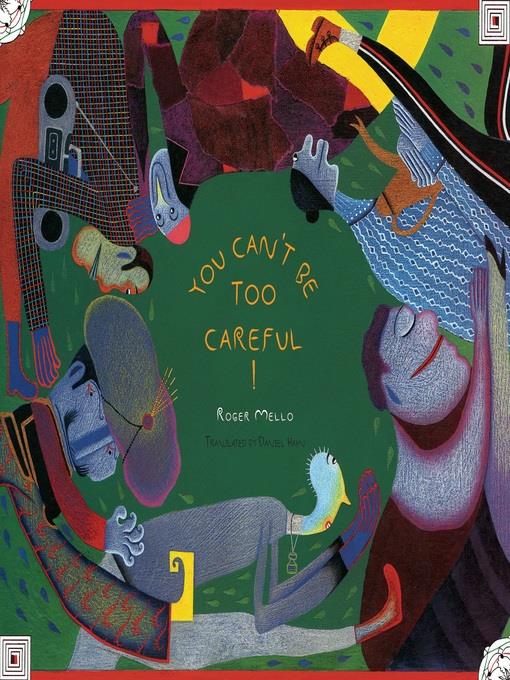
You Can't Be Too Careful!
فرمت کتاب
ebook
تاریخ انتشار
2017
Lexile Score
760
Reading Level
3-4
نویسنده
Daniel Hahnناشر
Steerforth Pressشابک
9780914671657
کتاب های مرتبط
- اطلاعات
- نقد و بررسی
- دیدگاه کاربران
نقد و بررسی

March 13, 2017
Hans Christian Andersen Award winner Mello unspools a long, strange chain of people and events, only to reverse course and present an alternate (and frankly much cheerier) timeline. It all begins with White Rose, a flower carefully watched by a gardener; he never leaves the flower’s side, not even after catching cold from walking around barefoot. The gardener’s shoes, Mello explains, were hidden by his cat, a gift from his brother, whose wife inherited the pet from her uncle, who “died of sorrow waiting for a love letter that never came.” More than a dozen eccentric interconnected characters are introduced from there—an escaped circus monkey, an irate goldsmith, a “fake doctor” with bagpiping dreams, and more. It’s like a floral equivalent to the butterfly effect, all leading back to White Rose, who suddenly reappears to steal the compass rose off a map. But how can she, if she’s still being watched by the gardener? Mello’s twisty, exaggerated images are as unruly as the paradoxical story he presents. Readers may not know what to believe, and when White Rose escapes at book’s end—for real, this time—it’s anyone’s guess what chaos might follow. Ages 5–8.

Starred review from January 15, 2017
Like the handle on a windup toy that moves clockwise until it stops and spins in reverse, the 2014 Hans Christian Anderson Award winner manipulates a chain of actions and consequences--and then imagines the momentum flowing backward with entirely different outcomes.As a barefooted gardener keeps watch over a white rose, the reasons for and importance of his shoelessness are traced through the motivations of eccentric characters. They include a man who dies brokenhearted after a seamstress's love letter is dropped by a letter carrier preoccupied with retrieving a ring and Rajah The Malodorous, whose sour-milk baths, prescribed by a charlatan, lead his betrothed to engineer her own kidnapping. Ultimately everything hinges on a map whose compass rose has been stolen, an unidentified someone claims, by the white rose. But wait--the narrator announces that the white rose couldn't have stolen the compass rose, thereby altering everyone's fates. Elegant linework mixes with torn paper and soft, textured colors as a parade of luminous, exotic caricatures and their accouterments unfold against a white backdrop; the effect is magical. The interactions probe issues around wealth, possession, and compassion. Mello's plot is made all the more mind-boggling with framing and intermediary scenes that are either voiced by an unreliable narrator or require fresh listening and looking. Complex and provocative, this Brazilian import will intrigue readers who like puzzles and frustrate those who don't. (Picture book. 8-12)
COPYRIGHT(2017) Kirkus Reviews, ALL RIGHTS RESERVED.

February 1, 2017
Gr 2-5-The first book published in the United States by the 2014 recipient of the prestigious Hans Christian Andersen Award is a thought-provoking exploration of the impact of kindness and greed. A barefoot gardener is meticulously guarding "White Rose," as she "might escape from her pen." We find out that the gardener's lack of shoes is the result of a long string of mishaps that are traced through a myriad of characters of all class levels, from workers to rajahs. Readers are propelled forward by text that spreads across the top of the pages' white background in a handwritten-style font, while the Brazilian author/illustrator's alluring collage and colored pencil images show the varied characters and their connected worlds. They come to a halt when they realize that everyone's misfortunes are linked to a missing compass. Someone whispers the suggestion that White Rose has hidden it, but readers are rewarded when they discover that White Rose couldn't have stolen the compass, as she is still "safely in her pen," and they are propelled back out, seeing everyone's fates changed in more positive ways. The story is open-ended, leaving children the chance to imagine what might come next but also wanting to return to the beginning to see how all the different pieces shift and come together.
Copyright 2017 School Library Journal, LLC Used with permission.

























دیدگاه کاربران